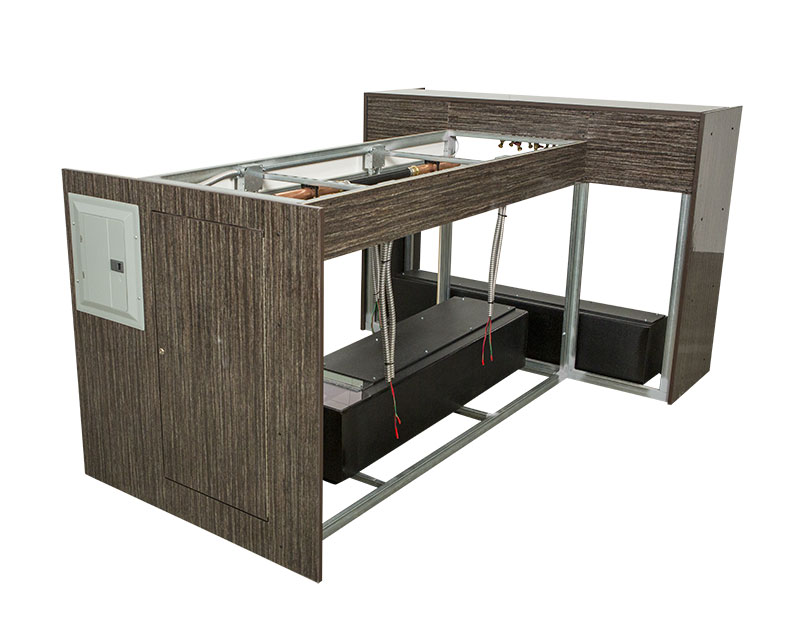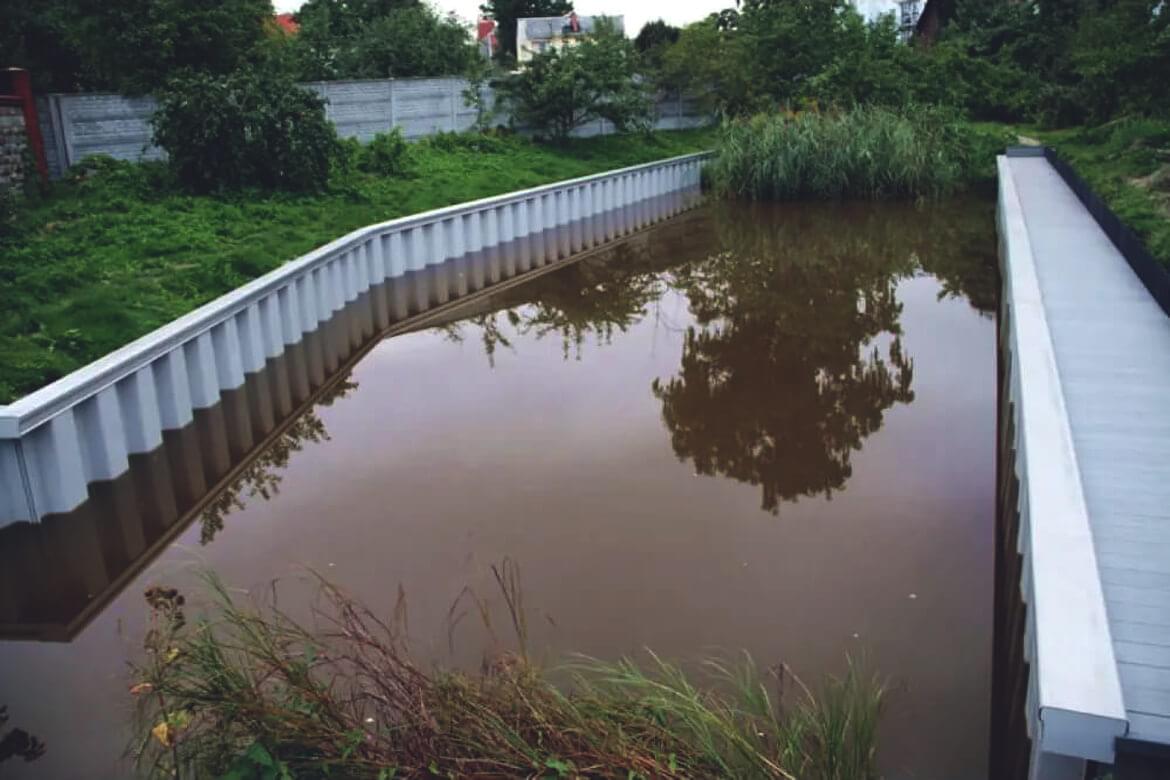Discovering the Various Uses Bulkhead Frameworks in Modern Style
Bulkhead structures play a considerable duty in modern-day architecture, offering both aesthetic and useful functions. They can define spaces, boost storage space solutions, and boost lights. In commercial settings, they function as centerpieces that mirror brand identification - Bulkhead on Lake Livingston. Additionally, their combination typically sustains audio monitoring and sustainable techniques. Understanding the complete extent of their applications reveals much regarding modern layout fads and customer experience. What ingenious uses bulkheads might emerge in the future?
Defining Bulkhead Frameworks
Bulkhead frameworks play a critical role in modern design, acting as important components in various structure layouts. These frameworks are generally specified as raised platforms or ceilings, often used to hide mechanical systems, circuitry, or plumbing. Bulkheads can be discovered in both commercial and domestic setups, where they supply a seamless mix of functionality and looks. Their style can integrate illumination fixtures and various other decorative aspects, improving the overall aesthetic charm of an area.
Generally constructed from products such as drywall, wood, or steel, bulkheads can be tailored to fit the architectural design and demands of the building (Bulkhead on Lake Livingston). They serve not only to hide undesirable infrastructure but likewise to develop defined zones within open spaces. By taking care of the flow of a room, bulkheads contribute to the spatial organization, making them a substantial aspect of modern architectural technique. Subsequently, their meaning envelops both functional and aesthetic dimensions
Practical Applications in Residential Layout
Bulkhead structures play a vital role in property layout by assisting in space optimization methods that make best use of usable areas. Moreover, they contribute visual style aspects that boost the visual charm of living rooms. Furthermore, these frameworks give essential structural assistance remedies, making certain the stability and safety and security of the home.
Area Optimization Approaches
As contemporary household designs increasingly prioritize effective use of room, cutting-edge strategies emerge to make the most of functionality without sacrificing appearances. One popular method includes the assimilation of bulkhead frameworks, which can define locations while giving vital storage services. These frameworks can be utilized to produce vertical storage devices that improve both organization and accessibility. Additionally, multi-functional furnishings, such as exchangeable sofas and foldable tables, complements bulkhead designs, allowing areas to adjust to varying demands. Open floor plans further maximize spatial circulation, urging adaptability being used. Integrating integrated shelving and recessed lights within bulkheads also adds to a structured setting, making certain that fully of area is made use of properly and harmoniously within the general design.
Aesthetic Style Aspects

Structural Assistance Solutions
In modern-day residential style, a reliable structural support service is vital for maintaining the stability of areas while optimizing design and functionality. Bulkhead frameworks play a considerable duty in this scenario, functioning as both support and partitioning aspects. They can hide mechanical systems, such as pipes and electric wiring, while offering support to the ceiling and floor systems. By purposefully placing bulkheads, engineers can develop specified locations within open layout, boosting use without compromising structural stability. Additionally, these structures can accommodate illumination fixtures, adding to both visual appeals and functionality. To summarize, bulkhead frameworks are indispensable in property layout, offering versatile support solutions that boost both the capability and aesthetic allure of living areas.
Enhancing Aesthetic Appeals in Business Rooms
When industrial spaces accept innovative bulkhead frameworks, they not just define physical boundaries however also significantly enhance the overall looks of the setting. These building aspects work as aesthetic focal points, drawing attention and creating a feeling of intrigue. By including varied products such as glass, timber, or metal, bulkheads can reflect a brand name's identity and mission, adding to a natural style.
Additionally, the strategic placement of bulkheads can adjust light and shadow, including depth and measurement to or else level areas. This interaction can change a business area into an inviting atmosphere, urging client engagement. In addition, making use of shade and structure in bulkhead layout can evoke certain feelings, boosting the overall consumer experience. Eventually, the thoughtful assimilation of bulkhead structures raises the visual charm of commercial rooms, making them not only practical yet also visually captivating, thus fostering a lasting perception on visitors.
Acoustic Performance and Noise Monitoring
Efficient acoustic performance plays an essential duty in contemporary style, especially within business spaces where sound administration is crucial. Bulkhead structures can greatly enhance acoustic high qualities by absorbing sound, reducing echo, and mitigating sound transfer between areas. These functions are specifically useful in settings such as restaurants, movie theaters, and offices, where clear communication and a pleasant auditory experience are critical.
The calculated positioning and style of bulkheads can aid produce sound-buffer zones, efficiently separating noisy areas from quieter ones. Products utilized in bulkhead building, such as soft surfaces and acoustic panels, add to their sound-dampening capacities. In addition, the incorporation of bulkheads enables the assimilation of sound-absorbing components without compromising aesthetic charm. By dealing with acoustic performance, architects can produce harmonious atmospheres that improve convenience, improve customer experience, and advertise efficiency, making bulkheads an essential component in the design of modern business rooms.
Incorporating Bulkheads for Effective Space Utilization
Although commonly overlooked, the integration of bulkheads in building style can significantly improve area application in modern-day buildings. These structural components serve several functional purposes, offering a means to hide mechanical systems, electrical wiring, and plumbing without jeopardizing visual appeals. By purposefully placing bulkheads, architects can produce specified locations within open layout, thus assisting in far better company and circulation.
Moreover, bulkheads can include storage space options and lighting functions, maximizing the capability link of or else wasted vertical area. In household settings, they might mark zones such as kitchen areas or living areas, while in business areas, they can enhance the efficiency of layouts by plainly marking paths and workspace.
Eventually, the thoughtful integration of bulkheads adds to a more visually attractive and orderly atmosphere, permitting adaptable rooms that can progress with the requirements of their occupants. This technique not just optimizes space but also cultivates an extra unified interaction in between form and function.
Bulkheads in Public Style

Architectural Visual Enhancements
While several building elements goal for performance, bulkheads in public design serve a double purpose by improving aesthetic appeal. These structures commonly develop visual passion with their design, integrating seamlessly with surrounding components. By employing numerous materials, appearances, and colors, bulkheads can contribute to a special identification for public areas, such as flight you can look here terminals, museums, and libraries. Their critical positioning aids to mark areas, guiding visitors while adding deepness to the total design. Additionally, bulkheads can emphasize lights, creating dynamic ambiences that alter throughout the day. This aesthetic enhancement not only boosts the site visitor experience however additionally promotes a local color, making bulkheads a crucial factor to consider in modern-day public design. Overall, bulkheads personify the fusion of type and feature.

Structural Support Solutions
As designers seek innovative means to enhance the structural stability of public spaces, bulkheads become crucial elements in the design and building process. These structures offer essential assistance, particularly in locations based on hefty foot traffic or vibrant tons. By distributing weight uniformly, bulkheads assist stop architectural failure while permitting functional style alternatives. In huge places, such as stadiums and convention centers, bulkheads are usually incorporated right into the total architectural structure, guaranteeing stability and security. Additionally, they can help with the incorporation of utilities and mechanical systems, adding to the effectiveness of area usage. Inevitably, bulkheads stand for a critical service in modern-day public architecture, strengthening both functionality and safety and security in community-focused atmospheres.
Environmental Management Measures
Integrating environmental security procedures right into public style has come to be significantly vital as urban designers focus on sustainability alongside architectural support. Bulkhead frameworks serve a double purpose hereof, functioning as barriers against erosion and flooding while all at once boosting the visual appeal of urban landscapes. Their layout usually includes natural components such as plant life, which can improve air high quality and supply environments for wild animals. Additionally, bulkheads can be crafted with permeable products that enable water absorption, minimizing overflow and advertising groundwater recharge. This combination of environmental factors to consider not just maintains the setting but also promotes neighborhood strength against climate modification. By using bulkheads efficiently, architects add to lasting metropolitan development that aligns with modern ecological objectives.
Future Trends in Bulkhead Layout
Arising fads in bulkhead layout reflect an expanding focus on sustainability, innovation, and capability in contemporary style. Designers are significantly incorporating environmentally friendly products, such as recycled composites and bioplastics, to reduce ecological effect. Additionally, the assimilation of clever technology is ending up being prevalent, allowing bulkheads to serve multi-functional objectives, consisting of power storage and climate control.
In metropolitan setups, modular bulkhead systems are getting grip, offering versatility in style and simplicity of setup. These systems can article source be adjusted to numerous landscapes, permitting reliable room application. Additionally, visual factors to consider are evolving; bulkheads are now being developed to enhance visual allure, usually integrating artistic components that reverberate with neighborhood culture.
As environment resilience becomes a concern, future bulkhead layouts will likely focus on flood protection and stormwater administration, ensuring structural honesty while dealing with ecological difficulties. This shift represents a holistic strategy to style that satisfies both human needs and ecological responsibilities.
Often Asked Inquiries
What Products Are Frequently Made Use Of for Bulkhead Building And Construction?
Usual materials for bulkhead building include concrete, steel, wood, and composite products. These alternatives offer toughness, architectural stability, and resistance to ecological elements, making them suitable for different applications in construction and design jobs.
Just How Do Bulkheads Impact Structure Power Effectiveness?
Bulkheads enhance building energy effectiveness by providing thermal insulation and lowering air leak (Bulkhead on Lake Livingston). They aid keep interior temperatures, therefore reducing home heating and cooling down needs, ultimately bring about lower energy costs and boosted environmental sustainability
Are There Any Type Of Building Regulations Specific to Bulkhead Structures?
Yes, constructing codes certain to bulkhead frameworks exist, varying by location. These laws normally attend to security, architectural integrity, and access, making certain that bulkheads fulfill called for criteria for building and layout within a given territory.
Can Bulkheads Be Conveniently Changed or Eliminated Later?
Bulkheads can often be modified or eliminated, relying on their design and construction. Such alterations may need careful preparation and adherence to structure codes to guarantee architectural honesty and safety and security are maintained throughout the process.
What Are the Prices Connected With Installing Bulkhead Structures?
The costs connected with installing bulkhead structures can differ substantially, generally affected by products, layout complexity, and labor. Usually, expenses vary from modest to high, relying on the job's details demands and area.
Bulkhead frameworks play an important function in modern architecture, offering as vital elements in different building styles. Bulkhead structures play an important role in residential layout by facilitating space optimization strategies that make the most of usable locations. Commonly overlooked, the assimilation of bulkheads in building design can considerably improve space application in contemporary buildings. As architects seek cutting-edge methods to improve the architectural stability of public areas, bulkheads emerge as essential parts in the style and construction procedure. The prices associated with setting up bulkhead frameworks can differ substantially, normally influenced by materials, layout intricacy, and labor.